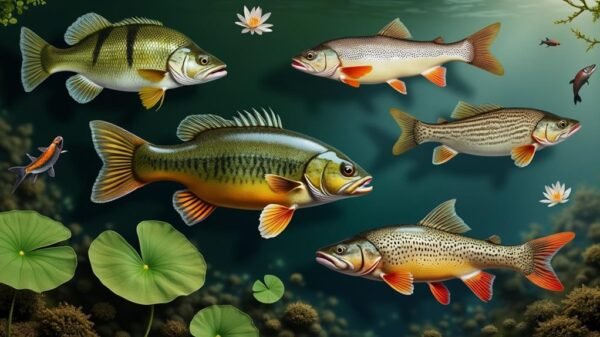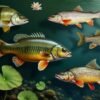Identifying common freshwater fish in your local lakes can be both enjoyable and rewarding. Start by looking for bluegills, characterized by their vibrant blue and yellow patterns. You might also spot largemouth bass, known for their strong build and aggressive nature, often found near rocks or submerged trees. Keep an eye out for catfish, recognized by their whisker-like barbels. Observing fish activity during dawn and dusk can increase your chances of catching them, especially in warmer months. Knowing these traits helps you appreciate your local ecosystem, while there's plenty more to learn about fishing techniques and seasonal patterns!
Understanding Freshwater Ecosystems
Freshwater ecosystems occupy approximately 0.8% of the Earth's surface yet host an astonishing diversity of organisms. These distinctive habitats, such as rivers, lakes, ponds, and wetlands, brim with life forms that flourish in freshwater environments. You may find it interesting that these habitats are not solely essential for fish; they also nurture amphibians, insects, flora, and avifauna. Engaging in activities like fishing in lakes and ponds reveals how these habitats promote varied aquatic species.
When you explore a nearby lake, you'll observe how water quality and current influence the types of organisms present. For example, swift-flowing streams typically harbor different fish species compared to tranquil ponds. Gaining insight into these ecosystems enhances your understanding of their interconnectedness. A shift in one component can reverberate throughout the entire habitat.
You can play an active role in preserving these vital areas. Simple steps, such as removing trash, minimizing chemical runoff, or joining local cleanup initiatives, can significantly impact conservation efforts. By appreciating and safeguarding freshwater ecosystems, you not only elevate your fishing adventures but also contribute to the preservation of the rich biodiversity within them. Dive into this journey, and you will discover that each trip to your favorite lake offers a chance to learn, appreciate, and bond with nature.
Key Characteristics of Common Species

Recognizing the key traits of common freshwater fish can enhance your fishing adventures and increase your appreciation for these aquatic species. Each fish exhibits unique characteristics that assist in identification during your next fishing trip. For example, the bluegill displays vibrant blue and yellow patterns, particularly noticeable during its spawning period. Among the most prevalent freshwater fish are species like the Largemouth Bass and Crappie, each showcasing distinct features.
The Largemouth Bass is known for its robust build and aggressive behavior. Often found near structures such as rocks or submerged trees, its triangular dorsal fin serves as a clear identifier.
Don't forget the Catfish, commonly residing at the lake's bottom. Its prominent whisker-like barbels are adept for detecting food in murky waters.
Identifying Fish by Appearance

When you're out on the lake, identifying a fish by its appearance can enhance your chances of landing a trophy catch. Begin by examining the fish's body structure. Most freshwater species, such as trout and perch, exhibit a streamlined form, while others, like catfish, have a more robust shape and notable barbels. Understanding that largemouth bass are prevalent can assist you in honing in on their identification.
Next, focus on color patterns. For example, bluegills display a striking azure area near their gills, whereas largemouth bass typically have a dark olive dorsal area and lighter lateral sides.
Pay close attention to fin characteristics! The configuration and dimensions of a fish's fins deliver vital information. Pike are recognized for their elongated, pointed dorsal fins, while crappies possess more rounded fins. Additionally, consider the fish's overall dimensions. Knowing the average lengths of common types, such as the 12-inch crappie or 14-inch bluegill, can aid in swift identification.
Behavioral Patterns in Freshwater Fish

Understanding fish behavior can significantly enhance your fishing success. When you visit your preferred lake, observe how species like bass and bluegill navigate and respond to their surroundings. For example, many freshwater species exhibit heightened activity during dawn and dusk, often searching for food. During these periods, you may find them near the water's surface, making it easier to catch them. Additionally, seasonal changes are crucial, as certain times of year can trigger increased activity due to spawning.
Consider water temperature as well. Fish typically seek cooler environments during hot weather, so look for shaded areas or deeper sections of the lake. Some species, such as largemouth bass, display territorial behavior and defend their nests during spawning. By recognizing these patterns, you can determine the best spots to cast your line.
Another important behavior to note is schooling. Fish like shad often swim in groups. If you encounter one, it's likely that others are in close proximity. Try using lures that mimic their movements to attract them effectively.
Seasonal Considerations for Fishing

Fishing success often depends on seasonal changes, as fish behavior and habitat preferences fluctuate throughout the year. In spring, rising water temperatures lead to increased activity among fish, prompting them to move into shallower waters for spawning. This period is ideal for catching species such as Largemouth Bass and White Crappie, as they are frequently located near the shoreline. Additionally, recognizing the effects of lake turnover can enhance your fishing strategy during this season.
In summer, warmer temperatures drive fish to seek refuge in deeper, cooler waters. Early mornings and late evenings become optimal times for fishing. Utilizing lighter tackle and targeting underwater structures can yield better results, as many fish, like Bluegill and Channel Catfish, tend to conceal themselves from the sun.
As fall approaches, fish intensify their feeding to prepare for winter. During this time, anglers should look for fish in shallower areas, particularly around vegetation. This season presents a fantastic opportunity to catch larger fish, as they actively search for food.
When winter arrives, fish exhibit significantly slower activity levels. Ice fishing can be fruitful, but it's crucial to focus on specific locations where fish congregate, such as near drop-offs or deep holes. Brands like Clam Outdoors and Eskimo offer quality gear to help enhance your ice fishing experience.



























